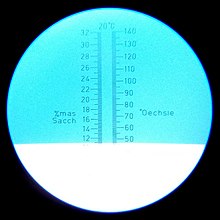Degree Oechsle

Degree Oechsle (abbreviated ° Oechsle or ° Oe ; after its inventor Ferdinand Oechsle ) is a unit of measurement for the must weight of the grape must , i.e. the unfermented grape juice .
The must weight is a measure of the proportion of dissolved substances (mostly sugar ) in grape must and thus an important quality criterion for wine . It is based on the density of the must and is measured with a must scale , a calibrated hydrometer .
Alternative measuring principles for the sugar content of the must are:
- optically with the refractometer (via the refractive index )
- regardless of the alcohol content with the saccharimeter (via the specific angle of rotation ).
definition
The amount of the must weight in ° Oe is obtained from the density of the must and the density of the water, each measured at 20 ° C, using the formula:
if the densities are given in kg per liter. The degrees Oechsle indicate by how many grams a liter of must weighs more than a liter of water.
Value ranges and interpretation
In general, the must weight of a middle year in Germany is between 70 and 80 ° Oechsle. The Oechsle value only gives a limited statement about the quality of the finished wine: particularly sweet grapes result in a wine with a particularly high alcohol content, but the taste also depends on many other factors, including the acidity .
The possible alcohol content of the fully fermented wine can be determined via the must weight, i.e. when the yeast cells have converted as much sugar into alcohol as they can (maximum about 18 % vol. , At a higher concentration they die). A must with 80 ° Oechsle results in a fully fermented wine with 84 grams of pure ethanol per liter, which corresponds to an alcohol content of 10.6% vol. Trockenbeerenauslesen can reach over 300 ° Oechsle - in the record summer of 2003 , a Trockenbeerenauslese measured 331 ° Oechsle.
In Germany there is an official "table for determining the natural alcohol content in percent by volume from the Oechsle grade":
|
|
|
|
|
|
International use
Different units are used internationally for the must weight, i.e. the sugar content of the juice:
- The degree Oechsle is used in Germany , Switzerland and Luxembourg .
- In the former sphere of influence of Austria , i.e. the countries of the former Austria-Hungary , the Klosterneuburger Mostwaage (KMW) is still in use today.
- In France and Spain 's degrees Baume in use.
- In English-speaking countries and in South America , the density measurement scale in degrees Brix is used, which is also known in the fruit processing industry.
See also
- Most weight - internationally used scales such as Klosterneuburger Mostwaage , Grad Baumé and Grad Brix are explained here.
Individual evidence
- ↑ Wolfgang Vogel: Wine from your own cellar. Grape, apple and berry wines. 7th revised and improved edition. Ulmer, Stuttgart 2004, ISBN 3-8001-4684-3 , p. 62.
- ↑ The Wine Box: Wine Records. Archived from the original on April 30, 2009 ; accessed on November 28, 2016 .
- ↑ The highest must weight of all time. In: Wine and entertainment - Weinrekorde, October 8, 2015. From Wein.de, accessed on January 3, 2019.
- ↑ Table for determining the natural alcohol content in percent by volume from the Oechsle grade. In: Wine Ordinance. Annex 8 to Section 17, 1995. On Rechts-im-Internet.de, accessed on January 3, 2019.
- ↑ Since Grad Baumé was excluded from the legal units in France by Decree No. 61-501 of May 1961 on units of measurement and the control of measuring instruments, the French regulation refers to the sugar content, expressed in grams per liter.




